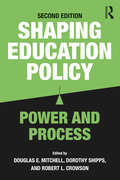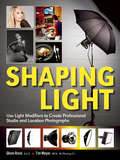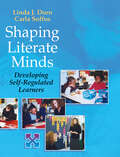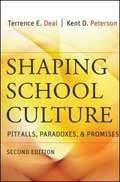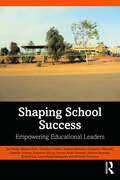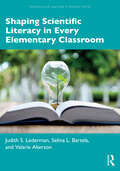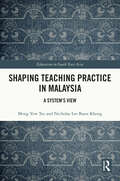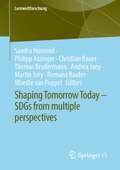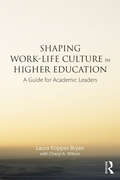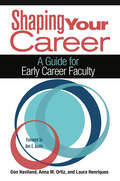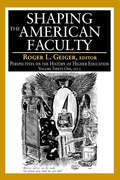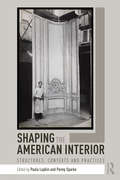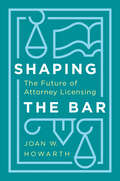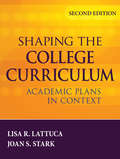- Table View
- List View
Shaping Academia for the Public Good
by Louise Potvin Pat ArmstrongWith increasing demands for evidence-based decision-making, the academic community must be ready to train researchers who can reduce the gap between health care research and practice. One program dedicated to promoting such training is the Canadian Health Services Research Foundation (CHSRF, now the Canadian Foundation for Healthcare Improvement) and Canadian Institutes for Health Research (CIHR) Chair Program. Participants of these programs were selected to develop innovative research programs that bridge this divide, as well as to mentor the next generation on building partnerships with organizations outside the university through applied research.The CHSRF/CIHR Chairs have come together in Shaping Academia for the Public Good to draw out valuable lessons learned throughout its first decade. It includes chapters on funding, knowledge transfer, policy frameworks, working with multiple stakeholders, and managing organizational settings, among other topics. Shaping Academia for the Public Good will be a helpful resource for those interested in the potential of new research approaches to improve our healthcare system.
Shaping Education Policy Discourse: Insights From Internationalization of Education Development in China (Exploring Education Policy in a Globalized World: Concepts, Contexts, and Practices)
by Jian LiThis book provides key insights into conceptualizing and contextualizing the education policy discourse model from the perspective of the internationalization of education development in China. It discusses the education policy discourse of international education with Chinese characteristics. It comprehensively covers the internationalization of education development, including the macro-perspective on the internationalization of education development in China, the quest for internationalization at home post-COVID-19, international education development in China, and mapping study abroad policy development in China. This book also explores the strategies regarding advancing the internationalization of education development in China contextually and systematically. This is a highly informative and carefully presented book, providing academic insight for readers with an interest in international education policy in China.
Shaping Education Policy: Power and Process
by Douglas E. Mitchell Dorothy Shipps Robert L. CrowsonShaping Education Policy is a comprehensive overview of education politics and policy, which provides conceptual guideposts for future policy development and strategies for change. Leading scholars explore the interacting social processes and the dynamics of power politics as they intersect with democratic ideals and shape school performance. Chapters cover major themes that have influenced education, including the Civil Rights Movement, federal involvement, the accountability movement, family choice, and development of nationalization and globalization. This edited collection examines how education policy in the United States has evolved over the last several decades and how the resulting policies are affecting schools and the children who attend them. This important book is a necessary resource for understanding the evolution, current status, and possibilities of educational policy and politics.
Shaping Education Reform in China: Overviews, Policies and Implications (Exploring Education Policy in a Globalized World: Concepts, Contexts, and Practices)
by Jian Li Eryong XueThis book examines the ways education reform has been shaped in China. Focusing on the past education policy development, it offers unique perspectives to illustrate China’s education reform and provides an overview of policies and their implications. In addition, the book discusses educational development, educational value, educational efforts and educational tasks and explores physical, aesthetic and labor education, as well as the management of off-campus training institutions and the policies on abolishing the “Five Only” in contemporary China. Conceptualizing the education reform model in China since 1949 for the first time, the book maps Chinese education policy development.
Shaping Future Schools with Digital Technology: An International Handbook (Perspectives on Rethinking and Reforming Education)
by Shengquan Yu Hannele Niemi Jon MasonThis book presents an overview of education technology and its use in schools, with a primary emphasis on best practices of technology enhanced learning; how new technologies such as mobile, augmented and wearable technologies affect instructional design strategies; and the content curriculum development process. Providing insights into the future of education and the upcoming pedagogies that will be applied in schools, it helps educators and other stakeholders make innovations for the new generations of learners in the 21st century.The use of emerging technologies such as mobile and ubiquitous technologies, context-aware technology, augment-reality, and virtual reality is contributing to making education adaptive and smarter. With the ever-changing technologies, how to equip teachers with these digital skills and transform their teaching style is also important to ensure that school education is more individualised and customised for students.Offering a global perspective with integrated practical cases, this timely book is of interest to educators, teachers, and education policymakers. And although most of the authors are from the academia, it provides non-experts with a novel view of what future schools will be like with the help of technology.
Shaping Human Science Disciplines: Institutional Developments in Europe and Beyond (Socio-Historical Studies of the Social and Human Sciences)
by Christian Fleck Matthias Duller Victor KarádyThis book presents an analysis of the institutional development of selected social science and humanities (SSH) disciplines in Argentina, France, Germany, Hungary, Italy, the Netherlands, Sweden and the United Kingdom. Where most narratives of a scholarly past are presented as a succession of ‘ideas,’ research results and theories, this collection highlights the structural shifts in the systems of higher education, as well as institutions of research and innovation (beyond the universities) within which these disciplines have developed. This institutional perspective will facilitate systematic comparisons between developments in various disciplines and countries. Across eight country studies the book reveals remarkably different dynamics of disciplinary growth between countries, as well as important interdisciplinary differences within countries. In addition, instances of institutional contractions and downturns and veritable breaks of continuity under authoritarian political regimes can be observed, which are almost totally absent from narratives of individual disciplinary histories. This important work will provide a valuable resource to scholars of disciplinary history, the history of ideas, the sociology of education and of scientific knowledge.
Shaping Light
by Glenn Rand Tim MeyerWhether shooting portraits or products, skillful lighting can be the difference between a bland snapshot and a stunning, well-defined image. Capturing the ideal photograph requires many technical factors to work in tandem, the most fundamental of which is lighting. While we may take it for granted that light is required to create a photograph, light by itself usually does not produce the style, energy, emotion or feeling that makes a photograph exceptional. It is the way the light has been modified and shaped that gives the photographer the ability to create an image that communicates their feeling about the subject. It's necessary to understand how light works in order to know how to modify it in the most desirous way.Beginning with simplified light concepts, Rand delves into the basics of light. Light's natural tendency is to go off in all directions. To give a better understanding of how to control the light that you use in your photographs, Rand guides the reader through a series of discussions defining the light itself, the surfaces that will interact with the light in the photographs, the look of light that we wish to create and the tools, modifiers and shapers that are commonly available for use. Whether you want to add contrast with highlights and shadows or use the softness of diffuse light to add volume to the subject, the fundamentals of these concepts are covered here. Images, diagrams and descriptions are used to illustrate the manners in which light can be modified.From there, the book moves onto the main tools of light modification. Rand discusses the primary functions of each tool and defines the issues of the light's characteristics after the modification. Techniques are presented for using reflectors, spotlights, softboxes, diffusers, umbrellas, barndoors, gels, scrims, shoots and more. Each chapter is highly illustrated with images of the tools being discussed, diagrams, and examples for the use of these tools in both commercial and portrait photography. Variations in control and problems that may occur with specific modifiers are discussed as well.The goal of this book is to show the effect of modifiers and shapers on the quality of light rather than to discuss the merits of a particular light source. By focusing on the methods to shape light, the photographer is open to improvise in scenarios where they may not have control over the light source. Whether you shoot commercial or portrait photography, this book provides you with the basis for not only successfully, but elegantly shaping light to create your desired result.
Shaping Light
by Glenn Rand Tim MeyerWhether shooting portraits or products, skillful lighting can be the difference between a bland snapshot and a stunning, well-defined image. Capturing the ideal photograph requires many technical factors to work in tandem, the most fundamental of which is lighting. While we may take it for granted that light is required to create a photograph, light by itself usually does not produce the style, energy, emotion or feeling that makes a photograph exceptional. It is the way the light has been modified and shaped that gives the photographer the ability to create an image that communicates their feeling about the subject. It's necessary to understand how light works in order to know how to modify it in the most desirous way.Beginning with simplified light concepts, Rand delves into the basics of light. Light's natural tendency is to go off in all directions. To give a better understanding of how to control the light that you use in your photographs, Rand guides the reader through a series of discussions defining the light itself, the surfaces that will interact with the light in the photographs, the look of light that we wish to create and the tools, modifiers and shapers that are commonly available for use. Whether you want to add contrast with highlights and shadows or use the softness of diffuse light to add volume to the subject, the fundamentals of these concepts are covered here. Images, diagrams and descriptions are used to illustrate the manners in which light can be modified.From there, the book moves onto the main tools of light modification. Rand discusses the primary functions of each tool and defines the issues of the light's characteristics after the modification. Techniques are presented for using reflectors, spotlights, softboxes, diffusers, umbrellas, barndoors, gels, scrims, shoots and more. Each chapter is highly illustrated with images of the tools being discussed, diagrams, and examples for the use of these tools in both commercial and portrait photography. Variations in control and problems that may occur with specific modifiers are discussed as well.The goal of this book is to show the effect of modifiers and shapers on the quality of light rather than to discuss the merits of a particular light source. By focusing on the methods to shape light, the photographer is open to improvise in scenarios where they may not have control over the light source. Whether you shoot commercial or portrait photography, this book provides you with the basis for not only successfully, but elegantly shaping light to create your desired result.
Shaping Literate Minds: Developing Self-Regulated Learners
by Linda Dorn Carla SoffosHow can teachers create a literacy curriculum that builds processing links between reading, writing, and spelling knowledge? In Shaping Literate Minds: Developing Self Regulated Learners , Linda J. Dorn and Carla Soffos illustrate how processing theory can be applied to the everyday practices of classroom teaching. If instruction emphasizes the interrelationships of these three language areas, students learn how to transfer knowledge, skills, and strategies across literacy events. This is complex theory, but the authors provide clear and practical examples to support teachers as they incorporate these ideas into their classroom practices. Grounded in authentic experiences from primary classrooms, this book provides: Explanations of processing behaviors among reading, writing, and spelling knowledgeObservational tools that support teachers in noticing changes over time in specific literacy behaviorsGuidance on creating conditions for developing self-regulated learnersAuthentic reading and writing samples and teacher/student interactionsFigures and pictures that clearly describe how teachers can use assessment to inform and guide instruction, with links to national standardsDetails for establishing a school-based literacy model that includes team meetings, assessment walls, high standards, and a curriculum for literacyAppendixes with reproducible assessment checklists, report cards, task cards for literacy corners, and guided reading observation forms for team meetingsWith a national emphasis on accountability, high standards, and literacy achievement, Shaping Literate Minds will help teachers and administrators implement a high-quality literacy curriculum that links to national and state goals.
Shaping School Culture
by Terrence E. Deal Kent D. PetersonA Guide for Shaping Your School's CultureIn this thoroughly revised and updated edition of their classic book, Shaping School Culture, Terrence Deal and Kent Peterson address the latest thinking on organizational culture and change and offer new ideas and strategies on how stories, rituals, traditions, and other cultural practices can be used to create positive, caring, and purposeful schools. This new edition gives expanded attention to the important symbolic roles of school leaders, including practical suggestions on how leaders can balance cultural goals and values against accountability demands, and features new and powerful case examples throughout. Most important, the authors show how school leaders can transform negative and toxic cultures so that trust, commitment, and sense of unity can prevail.Praise for Shaping School Culture"For those seeking enduring change that is measured in generations rather than months, and to create a legacy rather than a headline, then Shaping School Culture is your guide."-Dr. Douglas B. Reeves, founder, The Leadership and Learning Center, Englewood, CO"Deal and Peterson combine exquisite language, vibrant stories, and sage advice to support school leaders in embracing the paradoxical nature of their work. A 'must read' for all school leaders."-Pam Robbins, educational consultant and author"Once again, the authors have presented practitioners, researchers, professional developers, school coaches, and others with a tremendous resource for renovating and reinvigorating schools." -Karen M. Dyer, Ed.D., group director, Education and Nonprofit Sector Office, Center for Creative Leadership, Greensboro, NC
Shaping School Culture: The Heart Of Leadership (Education Ser.)
by Terrence E. Deal Kent D. PetersonThe most trusted guide to school culture, updated with current challenges and new solutions Shaping School Culture is the classic guide to exceptional school leadership, featuring concrete guidance on influencing the subtle symbolic features of schools that provide meaning, belief, and faith. Written by renowned experts in the area of school culture, this book tackles the increasing challenges facing public schools and provides clear, candid suggestions for more effective symbolic leadership. This new third edition has been revised to reflect the reality of schools today, including the increased emphasis on high-stakes testing, federal reforms such as No Child Left Behind (NCLB) and Every Student Succeeds Act (ESSA), state sponsored improvement programs, and other major issues that impact organizational culture and the role of school leaders. Each chapter features new examples and cases that illustrate persistent problems, spelling out key cultural implications and offering concrete examples of overcoming the challenges while maintaining a meaningful learning environment. The chapter on toxic schools continues to provide the field's most trusted advice on navigating this rocky terrain, and the discussion's focus on how to manage negativity remains especially integral to besieged school administrators across the U.S. Recent years have jolted the nation's school system with a number of new developments that spell problems for the cultural tapestry of schools. This book provides expert perspective and sage, doable advice for administrators tending to external pressures while sustaining—or evolving—a more positive school culture. Navigate new challenges including Every Student Succeeds Act (ESSA) and waning confidence and faith Turn around a toxic school culture with confidence and success Foster a culture of passion, purpose, and meaning Adopt a more active form of symbolic leadership to support students, faculty, staff, parents, and community Test scores as the primary metric, relentless reforms, waning public support, and timid initiatives wrapped in bureaucratic packaging: while among the most prominent issues administrators face are only the tip of the iceberg. Shaping School Culture charts a route through competing pressures to help educational leaders hew a positive learning environment for schools.
Shaping School Success: Empowering Educational Leaders
by Richard Lee Ian Hardy Christina Gowlett Shiralee Poed Stephen Heimans Elizabeth J Edwards Danielle Armour Katherine McLay Suraiya Abdul Hameed Andrew Beencke Laura Rueda Balaguera Michelle OcricianoThis book is a unique primer for school professionals, educators and policymakers to develop a solid understanding of the domains essential to cultivating and sustaining successful schools. It also provides essential reading for researchers interested in these issues more broadly.In response to various sensationalist discourses around schooling that dominate both mainstream and social media, the authors draw upon both long-standing and up-to-date research from around the world to present a more accurate, holistic, and optimistic approach. The book identifies the key domains that are necessary to address concerns in equity, leadership and teaching for enhanced student learning and wellbeing. Specifically, these domains relate to: (1) system-wide approaches to enhance school performance; (2) building teacher capability for student learning; (3) educational leadership as a vehicle for leading learning; and (4) building community ‘infrastructures’ for equitable, place-based learning. The book can be used in several ways: each chapter can be read as a stand-alone overview of key areas for school improvement. The broad topics are important jigsaw puzzle pieces that are necessary to ‘see the whole picture’ of a successful school/system. Each chapter includes ‘Key messages’ and ‘Ways forward’ and closes with extension questions to further guide thinking through the ‘big ideas’ presented in each chapter and how they are relevant to different schooling and policy contexts.Grounded in research into productive and proactive system and school practices from around the world, this book ensures professional educators are equipped with the latest research and practice, without being overwhelmed by the detail.
Shaping Scientific Literacy in Every Elementary Classroom (Teaching and Learning in Science Series)
by Judith S. Lederman Selina L. Bartels Valarie AkersonThis textbook guides teachers in enacting science instruction that results in the cultivation of scientifically literate students in elementary school. Prompting discussions in the pre-service environment around what it means to be scientifically literate, this book helps teachers introduce children to their world through science and its impact on their daily lives. Chapters show teachers how to design, implement, and assess inquiry-based science instruction through lessons that authentically model real science, investigating questions with multiple solutions, and discussing how these lessons build students’ scientific literacy. Sample lessons are modeled on research and tested practice while also recognizing the need to accommodate a diverse range of students and classroom contexts. Ideal for pre-service science teachers, as well as in-service professional development, this book can be used in any elementary science methods course or wherever state or national standards require developing scientific literacy. In helping teachers produce scientifically literate students, it is a resource that enables students to have the content knowledge, attitudes, and abilities to see the role science plays in issues from the personal to the global.
Shaping Students of Color from Preschool to Graduate School: The Impact of Families on Education
by Nathan DurdellaIlluminates how family-student interactions enhance the educational achievement of students of color/first-generation academics and applies these lessons to institutional goals.Shaping Students of Color from Preschool to Graduate School argues that family socialization and parent involvement in education influence paths to graduate school. Based on personal interviews with over thirty graduate students of color and first-generation graduate students, the text shows that families and parents use a complex system where cultural knowledge and behavioral modeling socialize children over the life course to promote specific values, including prioritizing education and hard work; building family unity and spirituality; honoring familial and ancestral sacrifices; fostering individual agency and personal autonomy at a young age; resisting gendered and racialized norms; and managing relationships in both personal and professional settings. These stories lay the groundwork for developing an asset-based understanding of what graduate students of color and first-generation graduate students bring to campus. Institutionally, what we learn can continue to build on the unique experiences and strengths of graduate students and enhance connections between personal and familial backgrounds and inclusive educational programming.
Shaping Teaching Practice in Malaysia: A System's View (Education in South East Asia)
by Meng Yew Tee Nicholas Lee Boon KhengWhat teachers do in the classroom is one of the most significant school-based factors in shaping student learning. Yet the classroom is often referred to as a 'black box' because there's so little we know about what actually happens there. This book provides insights into the ‘black box’ by describing and then comparing classroom practices in Malaysia’s national public school system and that of a unique subsystem situated within it. Through analysis of hundreds of hours of classroom video data, as well as interviews, this book goes on to identify and discuss the forces that shape teachers' classroom practices from across the ecological system. What emerged were nuanced insights of how tightly and loosely coupled forces within the centralised Malaysian national system shaped these teachers’ classroom practices, that are illustrated in multiple case studies. Additionally, this volume uncovers micro-disruptions to some tightly-coupled forces within the system that could begin to change teachers’ thinking about their classroom practice. These insights will be of interest to international and comparative education researchers, education policy makers and education professionals as well as anyone who has ever asked the question "Why do teachers do what they do in their classrooms?"
Shaping Tomorrow Today – SDGs from multiple perspectives (Lernweltforschung #39)
by Romana Rauter Christian Bauer Sandra Hummel Philipp Assinger Thomas Brudermann Andrea Jany Martin Jury Mireille Van PoppelThe volume provides a unique view on multidimensional crises, their interplay, and possible resolutions for sustainable life patterns and is therefore broadly related to the Sustainable Development Goals. Traditional unidimensional and technocratic strategies often fall short. Ultimately, people, their behavior and their habits are at the source of many problems. Therefore, it is imperative to take people, their multifaceted nature and the necessary learning and educational processes into account when striving towards a better life for everyone.
Shaping Work-Life Culture in Higher Education: A Guide for Academic Leaders
by Cheryl A. Wilson Laura Koppes BryanShaping Work-Life Culture in Higher Education provides strategies to implement beneficial work-life policies in colleges and universities. As compared to the corporate sector, higher education institutions have been slow to implement policies aimed at fostering diversity and a healthy work-life balance, which can result in lower morale, job satisfaction, and productivity, and causes poor recruitment and retention. Based on extensive research, this book argues that an effective organizational culture is one in which managers and supervisors recognize that professional and personal lives are not mutually exclusive. With concrete guidelines, recommendations, techniques, and additional resources throughout, this book outlines best practices for creating a beneficial work-life culture on campus, and documents cases of supportive department chairs and administrators. A necessary guide for higher education leaders, this book will inform administrators about how they can foster positive work-life cultures in their departments and institutions.
Shaping Your Career: A Guide for Early Career Faculty
by Anna M. Ortiz Don Haviland Laura HenriquesGoing beyond providing you with the tools, strategies, and approaches that you need to navigate the complexity of academic life, Don Haviland, Anna Ortiz, and Laura Henriques offer an empowering framework for taking ownership of and becoming an active agent in shaping your career.This book recognizes, as its point of departure, that faculty are rarely prepared for the range of roles they need to play or the varied institutions in which they may work, let alone understand how to navigate institutional context, manage the politics of academe, develop positive professional relationships, align individual goals with institutional expectations, or possess the time management skills to juggle the conflicting demands on their time.The book is infused by the authors’ love for what they do while also recognizing the challenging nature of their work. In demonstrating how you can manage your career, they weave in the personal and institutional dimensions of their experience and offer vignettes from their longitudinal study of pre-tenure faculty to illustrate typical issues you may have to contend with, and normalize many of the concerns you may face as a new member of the academy. This book offers you:• The resources, tips, and strategies to develop a strong, healthy career as a faculty member• Empowerment— you take ownership of and become an active agent in shaping your career• Advice and strategies to help women and members of traditionally underrepresented racial and ethnic groups navigate institutional structures that affect them differently• An understanding of the changing nature of academic work, and of how to grow and succeed in this new environmentWhile explicitly addressed to early career faculty, this book’s message of empowerment is of equal utility for full-time faculty, both tenure-track and non-tenure track, and can usefully serve as a text for graduate courses. Department chairs, deans, and faculty developers will find it a useful resource to offer their new colleagues.
Shaping of European Education: Interdisciplinary approaches (Studies in European Education)
by Romuald Normand Martin LawnThe range, speed and scale of Europeanizing effects in education, and their complexity, has produced a relatively new field of study. Using scholarship and research drawn from sociology, politics and education, this book examines the rise of international and transnational policy and the flow of data and people around Europe to study Europeanizing processes and situations in education. Each chapter creates a space for policy research on European education, involving a range of disciplines to develop empirical studies about European institutions, networks and processes; the interplay between policy-makers, stakeholders, experts, and researchers; and the space between the European and the national. The volume investigates the construction of European education, exploring the consideration of the role of think tanks and consultancies, international organizations, researcher mobilities, standards, indicators of higher education, and cultural metaphor. Bringing together international contributors from a variety of disciplines across Europe, the book will be of key value to academics, researchers and postgraduate students in the fields of education studies, politics and sociology.
Shaping the American Faculty: Perspectives on the History of Higher Education
by Roger L. GeigerBeginning in the twentieth century, American faculty increasingly viewed themselves as professionals who were more than mere employees. This volume focuses on key developments in the long process by which the American professoriate achieved tenure, academic freedom, and a voice in university governance.Christian K. Anderson describes the formation of the original faculty senates. Zachary Haberler depicts the context of the founding and early activities of the American Association of University Professors. Richard F. Teichgraeber focuses on the ambiguity over promotion and tenure when James Conant became president of Harvard in 1933. In "Firing Larry Gara," Steve Taaffe relates how the chairman of the department of history and political science was abruptly fired at the behest of a powerful trustee. In the final chapter, Tom McCarthy provides an overview of the evolution of student affairs on campuses and indirectly illuminates an important negative feature of that evolution�the withdrawal of faculty from students' social and moral development.This volume examines twentieth-century efforts by American academics to establish themselves as an independent constituency in America's colleges and universities.
Shaping the American Interior: Structures, Contexts and Practices
by Penny Sparke Paula LupkinBringing together 12 original essays, Shaping the American Interior maps out, for the first time, the development and definition of the field of interiors in the United States in the period from 1870 until 1960. Its interdisciplinary approach encompasses a broad range of people, contexts, and practices, revealing the design of the interior as a collaborative modern enterprise comprising art, design, manufacture, commerce, and identity construction. Rooted in the expansion of mass production and consumption in the last years of the nineteenth century, new and diverse structures came to define the field and provide formal and informal contexts for design work. Intertwined with, but distinct from, architecture and merchandising, interiors encompassed a diffuse range of individuals, institutions, and organizations engaged in the definition of identity, the development of expertise, and the promotion of consumption. This volume investigates the fluid pre-history of the American profession of interior design, charting attempts to commoditize taste, shape modern conceptions of gender and professionalism, define expertise and authority through principles and standards, marry art with industry and commerce, and shape mass culture in the United States.
Shaping the Bar: The Future of Attorney Licensing
by Joan HowarthThe comprehensive source on attorney licensing and how to reform it. In Shaping the Bar, Joan Howarth describes how the twin gatekeepers of the legal profession—law schools and licensers—are failing the public. Attorney licensing should be laser-focused on readiness to practice law with the minimum competence of a new attorney. According to Howarth, requirements today are both too difficult and too easy. Amid the crisis in unmet legal services, record numbers of law school graduates—disproportionately people of color—are failing bar exams that are not meaningful tests of competence to practice. At the same time, after seven years of higher education, hundreds of thousands of dollars of law school debt, two months of cramming legal rules, and success on a bar exam, a candidate can be licensed to practice law without ever having been in a law office or even seen a lawyer with a client. Howarth makes the case that the licensing rituals familiar to generations of lawyers—unfocused law degrees and obsolete bar exams—are protecting members of the profession more than the public. Beyond explaining the failures of the current system, this book presents the latest research on competent lawyering and examples of better approaches. This book presents the path forward by means of licensing changes to protect the public while building an inclusive, diverse, competent, ethical profession. Thoughtful and engaging, Shaping the Bar is both an authoritative account of attorney licensing and a pragmatic handbook for overdue equitable reform of a powerful profession.
Shaping the College Curriculum
by Lisa R. Lattuca Joan S. StarkShaping the College Curriculum focuses on curriculum development as an important decision-making process in colleges and universities. The authors define curriculum as an academic plan developed in a historical, social, and political context. They identify eight curricular elements that are addressed, intentionally or unintentionally, in developing all college courses and programs. By exploring the interaction of these elements in context they use the academic plan model to clarify the processes of course and program planning, enabling instructors and administrators to ask crucial questions about improving teaching and optimizing student learning.This revised edition continues to stress research-based educational practices. The new edition consolidates and focuses discussion of institutional and sociocultural factors that influence curricular decisions. All chapters have been updated with recent research findings relevant to curriculum leadership, accreditation, assessment, and the influence of academic fields, while two new chapters focus directly on learning research and its implications for instructional practice. A new chapter drawn from research on organizational change provides practical guidance to assist faculty members and administrators who are engaged in extensive program improvements. Streamlined yet still comprehensive and detailed, this revised volume will continue to serve as an invaluable resource for individuals and groups whose work includes planning, designing, delivering, evaluating, and studying curricula in higher education."This is an extraordinary book that offers not a particular curriculum or structure, but a comprehensive approach for thinking about the curriculum, ensuring that important considerations are not overlooked in its revision or development, and increasing the likelihood that students will learn and develop in ways institutions hope they will. The book brings coherence and intention to what is typically an unstructured, haphazard, and only partially rational process guided more by beliefs than by empirically grounded, substantive information. Lattuca and Stark present their material in ways that are accessible and applicable across planning levels (course, program, department, and institution), local settings, and academic disciplines. It's an admirable and informative marriage of scholarship and practice, and an insightful guide to both. Anyone who cares seriously about how we can make our colleges and universities more educationally effective should read this book."--Patrick T. Terenzini, distinguished professor and senior scientist, Center for the Study of Higher Education, The Pennsylvania State University
Shaping the Digital Transformation of the Education Ecosystem in Europe: 31st EDEN Annual Conference 2022, Tallinn, Estonia, June 20–22, 2022, Proceedings (Communications in Computer and Information Science #1639)
by Mart Laanpere Terje VäljatagaThis book constitutes refereed proceedings of the 31st Annual Conference on European Distance and E-Learning Network, EDEN 2022, held in Tallinn, Estonia, from June 20–22, 2022. The 11 full papers and 2 short papers presented in this volume were carefully reviewed and selected from a total of 78 submissions. The papers in the volume are organised according to the following topical headings: higher education; teachers’ professional development; digital competencies; inclusive education
Shaping the Education of Slow Learners (Routledge Library Editions: Special Educational Needs #3)
by W. K. BrennanFirst published in 1974. This book defines the slow learner, identifies the size of the problem presented by them, and outlines the responsibility of the ordinary school for their education. Then, successfully, characteristics of slow learners are reviewed and re-stated in a way relevant to their education; research on the post-school experience of slow learners is summarized and related to the curriculum; and general curriculum literature is reviewed in presenting a plan for the continuous development of curricula for slow learners, consistent with the modern approach to curriculum development.


